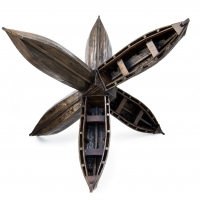In the search for a shore to safeguard the essences of his homeland, Alexis Leyva Machado (Kcho) discovered that safety lied in the promptness of the trip. Therefore, with an almost archeological procedure, he has put oars to our shipwrecked island.
His artistic strategy could be summarized as a constant work of collecting and giving new meanings to common objects –formerly saturated by use and signification–, to which he gives an unexpected poetical sense. In order to achieve this purpose, he uses techniques such as drawing and installation, which become means to generate a sort of insular assemblage. Thus colossal monuments come along, monuments devoted to Cuban identity, memory, history, and all those symbols that rein over the future of our culture. He has also made incursions on performance and he currently adventures himself on developing a community project in the Organic Museum of Romerillo, located in a town of Havana with the same name.
In Alexis Leyva’s work are merged diverse artistic influences, among the ones we can mention conceptualism, povera art, new realism, and the trans-avant-garde of late 20th Century. There can be also found in his aesthetic universe, as subtle influences, the presence of the Cuban sculptors José Antonio Díaz Peláez, Reynaldo Gonzáles Fonticiella and the prolific Antonia Eiriz.
We can detect in Kcho’s work an intense expressive tone, sustained by the use of rough textures, contrasting materials and a particular notion of terribilitá which moves the focus from the non finitu to the material and the hazard. This is one of the main reasons for including him into the commendable expressionist line of the national visual arts.
But when dealing with traditions, this creator has transformed the boundaries of sculpture through the possibilities offered by installation. Through this procedure he has taken possession of public areas, natural and social sites. His objects –stuck in the tracing of the city, and in common places for socializing–, have transformed the so far accepted notions of monumental sculpture and urban environments.
Inside Kcho’s universe of forms we will find the echo of our lands, of the roots that unify them, of the sea that both subdues and accompanies them, of their habitual rhythms and silences. It is Carpentier’s wonderland, Wifredo Lam’s fantastic visions, Roberto Diago’s imaginary oracles, Antonia Eiriz’s annunciating figures and the heart beating of this island, all of it condensed in images constructed with the expressive potency of a haiku.











